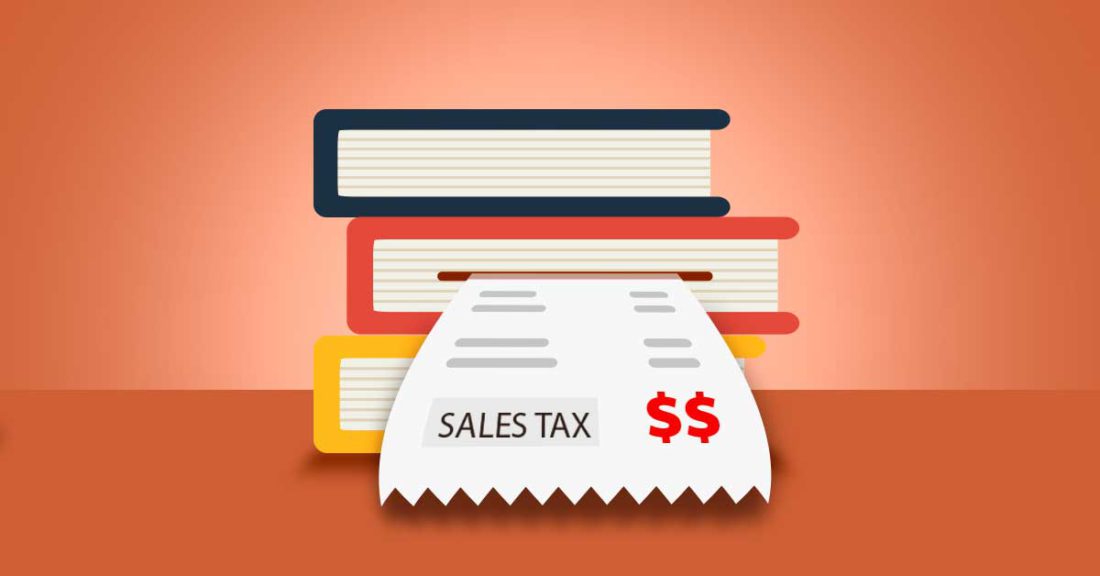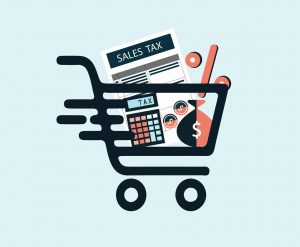As Benjamin Franklin said, there are two certainties in life: death and taxes. Sometimes, it’s a bit of a toss-up which one is less fun to talk about, but let’s jump right in and talk about taxes, specifically collecting sales tax from purchases people make through your e-commerce website.
Sales tax is very important, they fund essential state projects like schools, infrastructure, and public safety. As a background, sales tax is known as a “consumption” and a “pass-through” tax. That just means it’s only charged when a customer buys goods or services and it’s collected by the business to be sent to the state government.
Overall, tax laws are very complex. Since they’re governed by each state, it can vary widely. Some of the most common examples of the variations are:
• Products and services that are taxable
• Amount of sales tax
• When online sellers are required to file sales tax returns and how often
• Due dates for sales tax returns
An interest note: the acronym NOMAD can help you remember the five states without sales tax: New Hampshire, Oregon, Montana, Alaska, and Delaware.
We’ve broken down the steps to Sales Tax Compliance for you.
1. Determine what states you are required to collect sales tax in
2. Make sure your products are subject to sales tax
3. Register for a permit
4. Set up tax collection right on your website
5. Report your sales tax
6. File your sales tax returns
Now, this sounds like a lot, and we’re not going to be the one to tell you it isn’t. However, we are going to mention an alternate route before you get too much in the weeds. There are 3rd party solutions that will integrate your website and take care of everything.
We always recommend TaxJar: https://www.taxjar.com/pricing/ to our clients. There are others out there, but we’ve worked extensively with TaxJar and their resources and integration make all of this incredibly easy. Also, if you decide to go with a 3rd party system, you can get the account setup and then Surf Your Name can install the software on your website.
Now, if you’re still looking to take the DIY route or just want to learn a bit more about the system, let’s talk about the six steps.
Legally, the term to find out where you’re required to collect sales tax is called a “nexus” and means if you have a ‘tie’ to a particular state. Here is a list of things that ‘tie’ you to a state:
• Physical location: an office, warehouse, or store that’s listed as your place of business
• Personnel: an employee, contractor, salesperson, or anyone who does work for your business
• Inventory: If you store your products in a different state, you could be considered to have a tie there even if you have no personnel or business there.
• Sales: If you sell over $100,000 in product a year and/or 200+ transactions in a state, you’re required to pay that state’s sales tax.
• Affiliates: These are people not necessarily personnel, but advertise your products in exchange for a cut of profits.
• 3rd Party Shipping: Sometimes you’ll owe sales tax if you have a dropshipping relationship with a vendor.
• Tradeshow or other events: essentially temporary sales.
Note: The most common sales tax you’ll have is in selling over $100,000 and/or 200+ transactions in one particular state. As a key point, you’re required to collect sales tax from all buyers in states where one of the above applies.
1. Make sure your products are subject to sales tax
Most items that are considered ‘tangible personal property’ are taxed. For example, coffee mugs, décor, and cosmetics. However, other items are considered necessities such as grocery items and some clothing and are not taxes. Taxable products vary by state, so your products could be tax-exempt in one state but taxable in another.
Localities are another tax level to consider as a product could be exempt by the state, but taxable locally. It’s incredibly important to set up your shopping cart to collect sales tax correctly and not collect sales tax on non-taxable products.
2. Register for a permit
Once you’ve determined what states you need to pay taxes in and which products are subject to which taxes, it’s time to register your business with a state sales tax permit. You’ll have to register with each state and most allow you to do it online.
You must have your tax permit before you’re legally able to collect taxes, to do so without it, even if you’re registered but waiting for the permit number, is viewed as tax fraud.
When you’re registering for the permit, this is the general information you’ll need, some states may require more:
• Personal and business contact information
• SSN or Federal Employer Identification Number (AKA Employer Identification Number)
• Your business entity type
• NAICS Code (for online retailers this is it: 454110)
When you register, the state will give you a tax filing frequency and due date. The most common frequencies are monthly, quarterly, or annually, but some states also have semi-annual or unusual ones like twice-monthly depending on your size.
3. Set up tax collection right on your website
You have your permit, your filing frequency, and due date, know exactly how much to tax depending on your state ties. Now you can start collecting taxes! Remember if you have a tie in one state, you must collect taxes from all buyers in that state.
Some states have ‘origin-based’ sales tax collection, meaning tax collection is based on your location. This makes things easy since it’s the same for all purchases and you can input one number that applies to everyone.
However, most of the time you’ll collect destination-based taxes which is determined by a buyers ‘ship to’ address. This means tax rates change per purchase and you’ll need to have all the tax information for a particular state, city, county, and locality to collect accurately.
Another thing to think about is shipping. Some states consider shipping a necessity so when you charge for shipping, sales tax is added onto the total. Dropshipping is also where it gets a lot more complicated, it’s one of the most complex topics when it comes to sales tax. We’ll try to keep it simple and not get into the weeds.
With drop shipping, you’ll need to coordinate with your vendor and determine who is collecting sales tax. The amount of sales tax you list for the buyer is dependent on where you, your vendor, and your buyer are located and if you have a tie to that state to collect sales tax.
Your vendor might be required to charge you sales tax and you could be required to do the same for your customer.

Finally, when that filing date comes, it’s time to prepare your sales tax returns. Unless you’re filing in an origin-based state, you’ll need to know how much sales tax you collected not only in an entire state but county, city and down to the locality for the state government to allocate those taxes accordingly.
Even if you haven’t collected any sales tax for a state you have a tie to, you need to file a return. Not doing so could cost you fines and your permit.
5. File your sales tax returns
Most states allow if not require you to file your sales tax return online.
It’s recommended to file early so there’s time to address any issues and avoid late penalties. Even if you file at a date that seems to be on-time, electronic funds transfers can put a delay on the money getting to the state and it’s counted against you as a business.
Many states reward you for on-time filing by letting you keep about 1-2% of the sales tax collected, which might not be much but is still free money.
There you have it. The steps to collecting sales tax! It’s a long process with a lot of variables and if you’re doing it by yourself, we commend you. However, there are only so many hours in the day when you run a business. At the beginning of this article, we recommended TaxJar: https://www.taxjar.com/pricing/ as a third-party alternative to manage your sales tax collection. We encourage you to check out their website and learn more about how their services can help you from missing something or making a mistake in this overly complex topic.
As a reminder, we are not CPAs or attorneys. This is just our experience and you’ll need to chat with your CPA or attorney to get legal and tax advice specific to your business. We are here to help in any way we can because we have a wealth of experience in creating amazing e-commerce websites. We’ve seen the good, the bad, and the ugly when it comes to businesses navigating taxes and hope to help future clients with everything we’ve learned.
Whether you’re just starting or have been in business for decades, a website can open you up to huge opportunities for growth. Surf Your Name is here to bring your vision to life online with the perfect website to showcase all the products and services you have to offer. Contact us today and let’s create something amazing.








